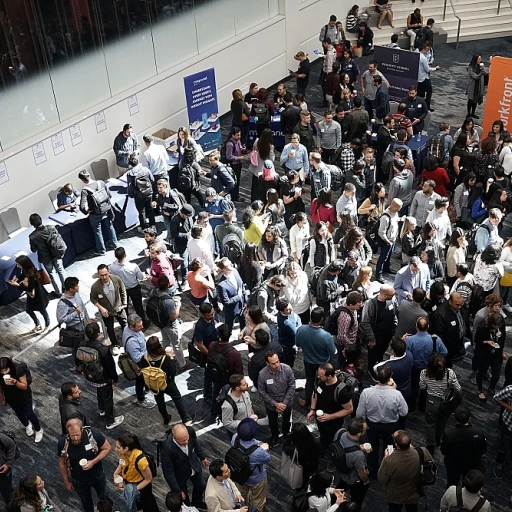
Understanding Employee Experience
Unlocking the Secrets Behind Employee Experience
Employee experience is a fundamental aspect of any successful workplace environment. It encompasses all interactions employees have with their organization, from recruitment to exit. Understanding the nuances of this experience is vital for businesses striving to foster a positive, engaging, and productive work environment.
At its core, employee experience involves various factors, from the physical workspace to the culture and values of the company. However, with the digital transformation happening globally, organizations are increasingly relying on technological innovations to enhance employee experience. This is where conversational AI-based solutions like chatbots and virtual assistants come into play.
These modern tools facilitate real-time interactions, providing support and data-driven assistance to employees. Chatbots, for instance, are designed to understand and process natural language, which allows them to communicate effectively and efficiently. They can handle various tasks, from customer service support to routine virtual assistant duties within an organization.
Nevertheless, while artificial intelligence is a powerful tool in the modern workspace, human interaction remains crucial. The role of human agents, or live assistants, is indispensable in situations that require empathy, complex decision-making, and understanding nuances that a purely automation-based system might miss.
By comparing the capabilities of chatbots and human assistants, organizations can better decide which combination of these tools will most effectively boost their employees' experiences. This comparison requires examining how both can handle conversational tasks, the level of personalization they offer, and their efficiency in providing customer support. As the workplace continues to evolve, balancing these elements is key to maintaining employee satisfaction and retention.
The Role of Conversational AI Chatbots
The Transformative Impact of AI Chatbots on Employee Assistance
Integrating conversational chatbots into the workplace has become a significant advancement in improving employee experience. These AI-driven tools are designed to handle a myriad of tasks traditionally performed by human assistants, revolutionizing how employees interact with organizational support systems. With the ability to process natural language, conversational chatbots provide immediate and efficient support, creating an intuitive user experience. Instead of waiting for availability from human agents, employees can engage with virtual chatbots for real-time answers to their inquiries. One of the standout benefits of using chatbots is their capability to manage frequently asked questions and routine tasks. Rule-based chatbots can assist employees in services like customer support inquiries and data retrieval, freeing up human agents for more complex decision-making processes. Additionally, machine learning enhances these AI solutions, enabling them to adapt from previous interactions to improve response accuracy. These AI-powered chatbots don't just replicate human tasks; they extend the range of support by operating 24/7, ensuring employees have access to the help they need, anytime. This consistent availability is particularly beneficial for global organizations operating across different time zones. Conversational chatbots serve as a foundational component in modernizing employee assistance systems. Their implementation can provide a competitive edge, fostering a culture that encourages seamless communication and interaction amongst employees. For businesses looking to explore how to sustain such engaging environments, this insightful source offers guidance on creating a workplace culture focused on retention and engagement. In summary, conversational AI chatbots are transforming the landscape of workplace assistance, ensuring improved efficiency, better resource allocation, and heightened employee satisfaction through their advanced support capabilities.Human Assistants in the Workplace
The Impact of Human Assistants in Enhancing Employee Experience
Human assistants play a crucial role in fostering a positive employee experience. Their presence in the workplace often brings a sense of empathy and understanding that is challenging to replicate with technology alone.- Empathy and Personal Touch: Human assistants possess the unique ability to empathize with their users, offering personalized support where machine interactions might fall short. Their capacity to understand nuances in language and context allows them to handle complex or sensitive issues effectively.
- Complex Problem Solving: While chatbots have advanced significantly, human assistants still excel in complex decision making and problem-solving scenarios involving emotional intelligence. Their ability to adapt and provide tailored responses can be critical in situations where employee emotions and motivations are key.
- Real-time Adjustments: Adaptability in the workplace is another strength of human assistants. They can make real-time adjustments based on employee feedback, constantly refining their service to better meet the needs of those they support.
- Enhancing Interactions: Human assistants can enrich interactions by leveraging their experience and knowledge, making informed suggestions that can improve processes and workflows.
Comparative Analysis: Chatbots vs. Human Assistants
Benefits and Drawbacks: A Balanced Perspective
In the evolving landscape of workplace advancements, both conversational AI chatbots and human assistants play pivotal roles in enhancing employee experience. Understanding the comparative advantages and limitations of each can help organizations make informed decisions.Advantages of Conversational AI Chatbots
- Efficiency and Availability: Chatbots excel in handling repetitive tasks, offering 24/7 support that human agents simply cannot match. This ensures employees have access to assistance around the clock, improving overall experience and task efficiency.
- Scalability: With AI-driven chatbots, companies can scale support operations quickly without the need for expanding the workforce, offering a cost-effective solution for growing organizations.
- Data Processing: Chatbots can analyze large volumes of data, providing insights through natural language processing. This enables chatbots to learn and adapt, enhancing interactions over time.
Advantages of Human Assistants
- Complex Decision Making: Humans excel in complex problem-solving and decision-making processes. In situations requiring empathy or nuanced understanding, human assistants are irreplaceable.
- Emotional Intelligence: Unlike chatbots, human assistants are capable of emotional interactions, providing compassion and understanding in employee support.
- Language Nuance: While chatbots can understand and process language, human assistants better comprehend linguistic nuances, making them more effective in personalized interactions.
Drawbacks of Each Approach
- Chatbots Limitations: Despite advanced machine learning, chatbots may struggle with non-standard queries and require rule-based programming. This could lead to user frustration when trying to perform unique tasks outside programmed parameters.
- Human Resource Constraints: Relying solely on human assistants can lead to resource limitations. They cannot offer real-time support due to work hours, potentially delaying assistance.
Integrating for Optimal Experience
For an enhanced employee experience, a hybrid approach leveraging both chatbots and human assistants is often optimal. While chatbots handle straightforward, repetitive tasks, human agents can address more complex and sensitive issues. By combining these elements, organizations can streamline customer service and employee interactions, leading to a supportive and responsive environment. This balance ensures that both technological and human strengths are played to their fullest, creating a workplace that fosters employee satisfaction and retention.Case Studies: Successful Implementations
Real-World Success Stories
In recent years, several organizations have successfully implemented conversational AI chatbots and human assistants to enhance the employee experience. These cases highlight how these technologies can be leveraged to improve efficiency, engagement, and satisfaction among employees.
Streamlining Customer Support with Chatbots
One notable example is a global retail company that integrated conversational chatbots into their customer service operations. By employing chatbots, they managed to handle a significant volume of customer inquiries in real time, freeing up human agents to focus on more complex issues. This not only improved customer support but also reduced the workload on employees, enhancing their overall experience.
Enhancing Employee Interactions with Virtual Assistants
A tech firm adopted virtual assistants to assist employees with routine tasks such as scheduling meetings and managing emails. The virtual assistants, powered by natural language processing and machine learning, provided personalized support, allowing employees to focus on higher-value tasks. This implementation resulted in increased productivity and a more satisfying work environment.
Data-Driven Decision Making in the Financial Sector
In the financial industry, a company utilized AI-based chatbots to analyze large volumes of data and provide insights to employees. These chatbots assisted in decision-making processes by delivering timely and accurate information, thus enhancing the efficiency and effectiveness of human agents. Employees reported higher job satisfaction due to the reduced pressure of data analysis tasks.
Blending Human and Artificial Intelligence in Healthcare
In the healthcare sector, a hospital implemented a hybrid model combining human assistants with AI chatbots. This approach allowed for seamless interactions between patients and healthcare providers, improving the quality of service. The chatbots handled routine inquiries, while human assistants focused on personalized patient care, creating a balanced and effective support system.
These case studies illustrate the potential of conversational AI chatbots and human assistants in transforming the employee experience across various industries. By strategically implementing these technologies, organizations can foster a more engaging and efficient workplace.
Future Trends in Employee Experience Enhancement
Emerging Technologies Shaping Employee Interactions
As the landscape of employee experience continues to evolve, a focus on integrating cutting-edge technologies like conversational chatbots and virtual assistants is becoming mainstream. With advancements in artificial intelligence and machine learning, organizations are now exploring innovative solutions to enhance user interactions and streamline employee tasks.
The use of natural language processing and machine learning is at the forefront, allowing chatbots to handle complex queries and perform real-time interactions with employees. These virtual assistants are continually learning and adapting through data-driven insights, which helps in personalizing the experience for each user.
Seamless Integration of Technology and Human Touch
While chatbots are gaining momentum, human assistants still play a vital role in providing empathetic and nuanced support. The key to enhancing employee experience lies in creating a balanced ecosystem where technology complements the human element—leveraging both artificial intelligence for efficiency and human agents for decision making.
Predictive Support and Proactive Engagement
Future trends point towards predictive customer support and proactive engagement in employee experience frameworks. By utilizing data analytics, conversational chatbots can anticipate employee needs and deliver solutions before issues arise. This predictive capability enhances employee satisfaction and fosters a more supportive work environment.
Transformative solutions like these are not only increasing the scope of what chatbots can do but also expanding traditional customer service models, enabling more comprehensive and anticipatory support structures within workplaces.












